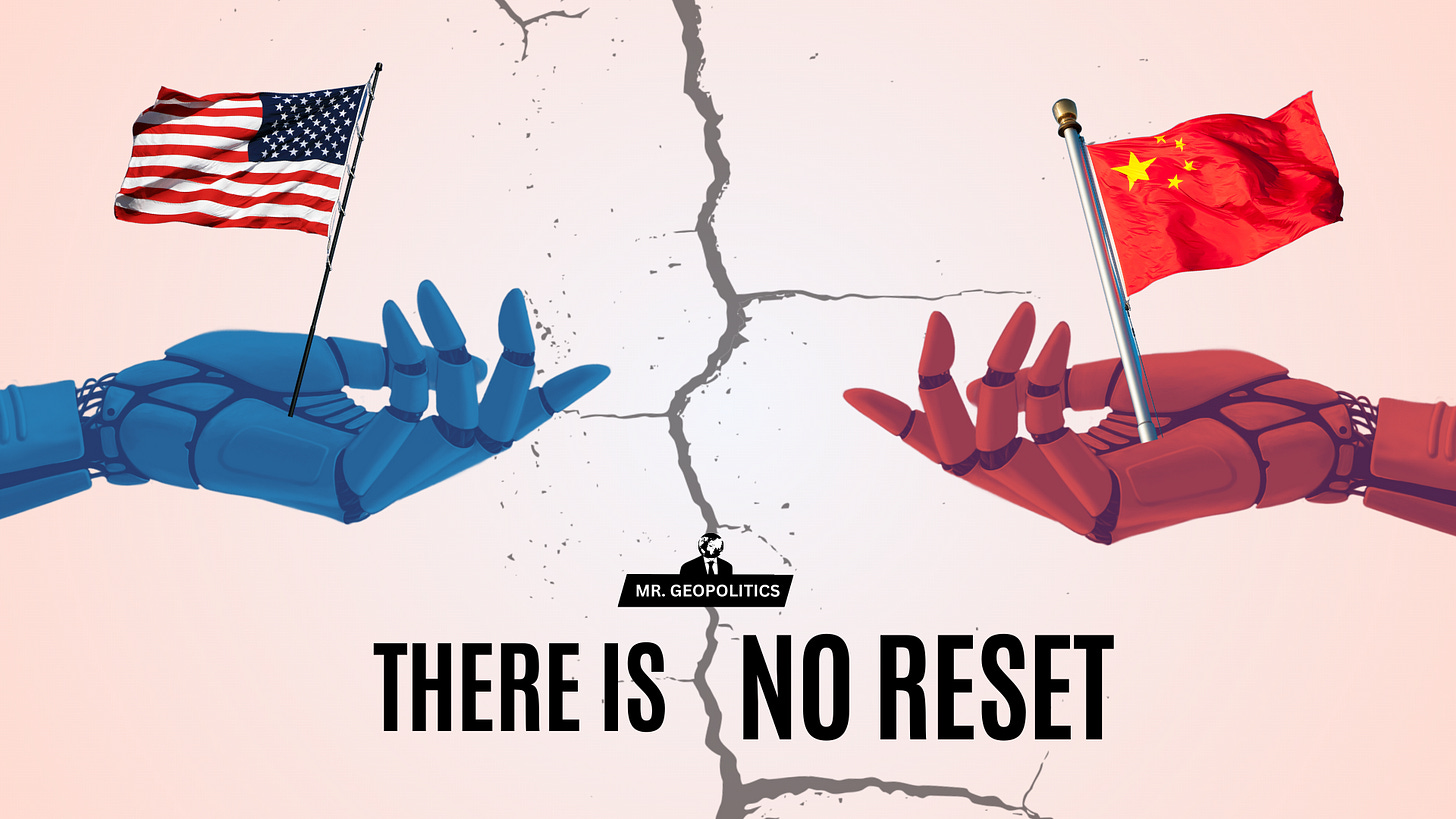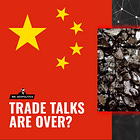Forget A Deal. The US-China Fight Has Only Begun.
Why a detente is dead on arrival
After the US-China tariff pause earlier this year, something strange occurred on Wall Street. Many investors were convinced that the worst was over—that the real “blows” and “uncertainty” were behind them. Such a sentiment drove new market rallies and “absorbed” the shocks of new trade tensions, like between the US and EU or the US and Japan (see sidebar).
[Sidebar: For now, the US-Japan trade deal is in limbo as Washington and Tokyo lock horns on how Japan’s $550 billion investment commitment should be spent in the US. And, as the White House proposes government investment to revive factories and manufacturing, further bringing the state into the economy, kind of like China.]
Many on Wall Street, and elsewhere, seemed to ignore the signs, all of which pointed to the same thing: there was no trade war between the US and China. Instead, a 21st-century economic war had begun that would reshape the world—a sentence I have repeated for months now. A tariff pause did not mean the worst was over. Far bigger and more significant shocks would strike. Within 60 days, by July, global alarm bells were ringing as China weaponized rare earth exports.
👁 GEOPOLITICAL FORESIGHT ON US-CHINA FUTURE
Yet today, the world is in a similar situation. Talk of a TikTok deal and a call between US President Donald Trump and Chinese President Xi Jinping are making it seem that a US-China detente is about to occur. Do not be fooled. Even if a deal is signed, even if Trump and Xi stand together smiling, it does not take away from reality. The US and China are firmly locked in a fight that no trade deal or diplomacy can stop—and both sides know it.
STATUS QUO
Just consider the state of play as Trump and Xi speak:
China has banned some of its largest technology firms from using AI chips that Nvidia developed specifically for the Chinese market.
In less than a month, new shipping rules will come into effect, charging a fee for ships that dock at US ports if the vessel is made in China or is operated by a Chinese firm.
The first US-China pharmaceutical joint venture, formed in 1982, has fallen apart as Bristol Myers Squibb prepares to sell its 60% stake.
The Mexican government is raising tariffs on certain Chinese imports, like cars, from 20% to 50%, sidelining Mexico-China relations.
TikTok’s future in the US, even under American control, could still house the Chinese algorithm, contradicting the entire point of the deal (national security) if the Chinese AI remains in American society.
This is just a peek into the environment that surrounds any US-China deal or talk of such an agreement. In reality, whatever is inked will simply be a pause in certain hostilities as both sides strike in other ways. And if there is no deal, the US and China will time-travel back to April. Equally important is how exactly either side can justify a deal, especially the US, considering what is taking place (e.g., US firms being phased out of the Chinese market).
SUPERPOWER LOGIC
Now, the big question. Deal or no deal, if the end result is the same (the US-China economic war), then how should executives and policymakers think about what is happening? And, perhaps more significantly, if collision is the new status quo, what happens next?
The first question—how should stakeholders be interpreting what is happening—is complicated.
This is a relationship where both sides are zigzagging, bouncing around, doing U-turns, and giving off the most mixed signals. If this were happening in the animal world, between two birds or tigers, the observers would assume serious problems. The reality is that the US and China are trying to manage several headaches at once:
In the US, economic warning signs are blinking. In August, the US economy added just 22,000 jobs. Then, the jobs data for June was recalculated, showing that 13,000 jobs had disappeared (it previously showed 14,000 jobs were added), meaning the US economy lost jobs, the first negative report since December 2020. Add to this, the US unemployment rate has reached an almost four-year high, inflation is up 2.9%, and the White House and Federal Reserve are more divergent than ever. The outcome: the US may not be able to afford a fresh fight with China. It could shatter an already fragile economic state. And the 90-day extensions cannot keep being doled out. A deal is needed to keep markets calm and the economy from deteriorating—even if the deal itself does not stop either side from colliding.
China cannot replace Western markets. The Chinese push to replace America (and the West) appears to have hit a wall. China’s export growth rate has slowed to its slowest pace in six months (exports to the US are down 33%). This comes as Chinese exports to ASEAN are up 22.5% and China’s trade surplus with Africa hit $60 billion in August—more than all of 2024. Except, even with Chinese trade redirection, overall exports are lower. This means the emerging markets are still far from replacing Western markets. China wants to regain access to the richest markets in the world (i.e., the US and Europe), and the “master key” is a deal with Trump. At least in the short term, before the next disruption occurs, China can sell into America, and potentially other parts of the West, without the fear of tariffs being reimposed.
The Chinese know the new game. The White House will not like it, but China is in the power position in the trade talks. Besides a few “wins” to lock China out, like a 40% transshipment tariff through the US-Vietnam deal, Washington’s other plays against China have not worked (e.g., look at Panama ports). All China did to bring America to the negotiating table was cut rare earth exports. That is 1% of China’s arsenal. The Chinese are calculated, always playing the long game. And from this logic, there is no point in colliding with America right now, when it may be easier to collide in the future (i.e., when China has even more leverage from its economy to finance).
Peak Tariffs and Peak America are merging? Without acknowledging it, many in Washington, potentially in the Oval Office itself, are seeing certain signs. Modi’s visit to China, Kenya converting USD debt to Yuan, Brazil’s new outreach to Beijing, to name a few. This is not insignificant. The key capitals of the Global South are shifting away from America because of trade tariffs and America’s unilateral behavior. If the US can ink a trade deal with China, it may be able to slow this new direction of countries. What is looming is that Trump might wind down the use of tariffs, only using them in “exceptional cases” (e.g., if a war breaks out to bring the warring parties to the table). Just as China needs a deal with America to reopen the West, so too, the US needs a deal with China to keep the Global South operating a certain way.
A key point from above: “even if the deal itself does not stop either side from colliding.” This goes to the heart of this geopolitical foresight. The US and China are only in the opening rounds of their competition, fight, rivalry, or however one wants to phrase it. No deal will stop or slow this. A deal or “framework agreement” will only provide an artificial reprieve.
There are, of course, several other reasons why the US and China need a deal at this moment. But these are the most significant. The state of the US and Chinese economies is not rosy. And, the broader geopolitics around them—benefiting China, challenging America—make a deal more necessary. Surrounding all this, the Chinese do not seem like they are in a hurry to sign a trade deal, once again reflecting their belief (real or perceived) that they have the leverage. Have the Chinese perfected the Art of the Deal?
What Happens Next?
Now the focus turns to the horizon.
The signals make it clear that there is no permanent stability forming. The chasms between the US and China have become unbridgeable: technology, climate, finance, alliances, etc. This is not cynicism. This is reality. The world’s two superpowers have strayed so far from each other over the last decade that attempting some kind of “quick patchup” is like trying to fix a broken marriage with a cocktail party. For a brief moment, it might seem like it is working, but by the time morning arrives, everybody is back to their old behaviors.
Global stakeholders must start planning for new geopolitics between the US and China. If a deal is not struck, what either side will do toward the other will eclipse anything seen so far. If a deal is struck, a new status quo will set in that threatens the global economy.
All of the key scenarios and directions are presented in the new geopolitical foresight briefing: Next US-China Flashpoints.
The biggest decision companies and governments can make is to see through the optics—cut through the noise. The world is fracturing, a holistic agreement is not even being discussed, and beyond trade, the US and China are at war in many other domains.
Strangely, deals and agreements are supposed to outlast and overpower tensions and differences. Yet, when it comes to the US and China, it will be the opposite.
As the stakes rise, the differences, the divergences, and the sheer drive to call the shots will outlast and overpower any deal. Within a short time, both countries will reach a point where they have to pick between maintaining stability and advancing geopolitics. And based on everything said so far, it is becoming clear which path will be picked.
-ABISHUR PRAKASH AKA. MR. GEOPOLITICS
Mr. Geopolitics is the property of Abishur Prakash/The Geopolitical Business, Inc., and is protected under Canadian Copyright Law. This includes, but is not limited to: ideas, perspectives, expressions, concepts, etc. Any use of the insights, including sharing or interpretation, partly or wholly, requires explicit written permission.
Have questions or thoughts? Let’s talk: mrgeopolitics@substack.com
If you like Mr. Geopolitics, your colleagues might too.
Feel like doing something unique for somebody important?








